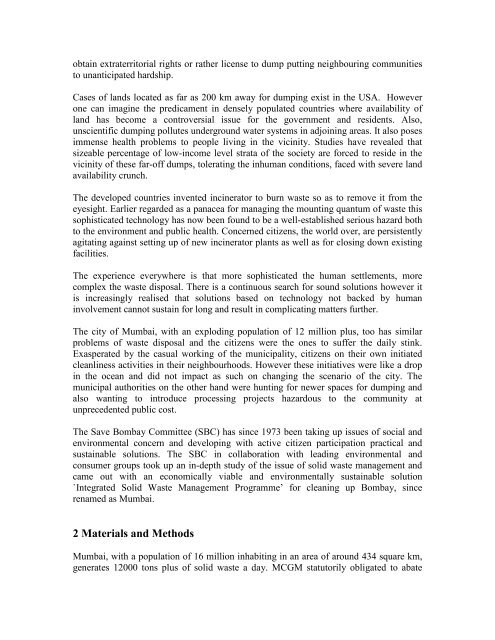Integrated Solid Waste Management - Save Bombay Committee ...
Integrated Solid Waste Management - Save Bombay Committee ...
Integrated Solid Waste Management - Save Bombay Committee ...
You also want an ePaper? Increase the reach of your titles
YUMPU automatically turns print PDFs into web optimized ePapers that Google loves.
obtain extraterritorial rights or rather license to dump putting neighbouring communities<br />
to unanticipated hardship.<br />
Cases of lands located as far as 200 km away for dumping exist in the USA. However<br />
one can imagine the predicament in densely populated countries where availability of<br />
land has become a controversial issue for the government and residents. Also,<br />
unscientific dumping pollutes underground water systems in adjoining areas. It also poses<br />
immense health problems to people living in the vicinity. Studies have revealed that<br />
sizeable percentage of low-income level strata of the society are forced to reside in the<br />
vicinity of these far-off dumps, tolerating the inhuman conditions, faced with severe land<br />
availability crunch.<br />
The developed countries invented incinerator to burn waste so as to remove it from the<br />
eyesight. Earlier regarded as a panacea for managing the mounting quantum of waste this<br />
sophisticated technology has now been found to be a well-established serious hazard both<br />
to the environment and public health. Concerned citizens, the world over, are persistently<br />
agitating against setting up of new incinerator plants as well as for closing down existing<br />
facilities.<br />
The experience everywhere is that more sophisticated the human settlements, more<br />
complex the waste disposal. There is a continuous search for sound solutions however it<br />
is increasingly realised that solutions based on technology not backed by human<br />
involvement cannot sustain for long and result in complicating matters further.<br />
The city of Mumbai, with an exploding population of 12 million plus, too has similar<br />
problems of waste disposal and the citizens were the ones to suffer the daily stink.<br />
Exasperated by the casual working of the municipality, citizens on their own initiated<br />
cleanliness activities in their neighbourhoods. However these initiatives were like a drop<br />
in the ocean and did not impact as such on changing the scenario of the city. The<br />
municipal authorities on the other hand were hunting for newer spaces for dumping and<br />
also wanting to introduce processing projects hazardous to the community at<br />
unprecedented public cost.<br />
The <strong>Save</strong> <strong>Bombay</strong> <strong>Committee</strong> (SBC) has since 1973 been taking up issues of social and<br />
environmental concern and developing with active citizen participation practical and<br />
sustainable solutions. The SBC in collaboration with leading environmental and<br />
consumer groups took up an in-depth study of the issue of solid waste management and<br />
came out with an economically viable and environmentally sustainable solution<br />
`<strong>Integrated</strong> <strong>Solid</strong> <strong>Waste</strong> <strong>Management</strong> Programme’ for cleaning up <strong>Bombay</strong>, since<br />
renamed as Mumbai.<br />
2 Materials and Methods<br />
Mumbai, with a population of 16 million inhabiting in an area of around 434 square km,<br />
generates 12000 tons plus of solid waste a day. MCGM statutorily obligated to abate


